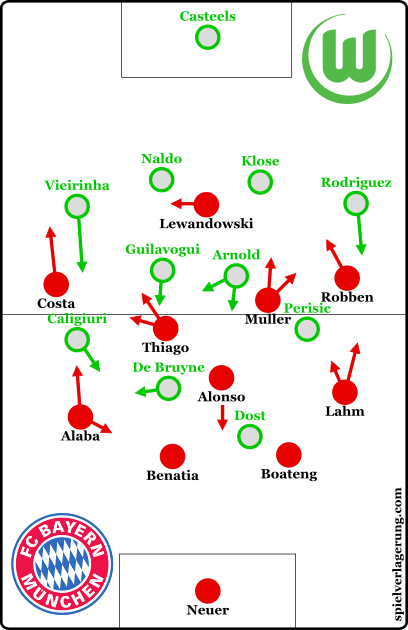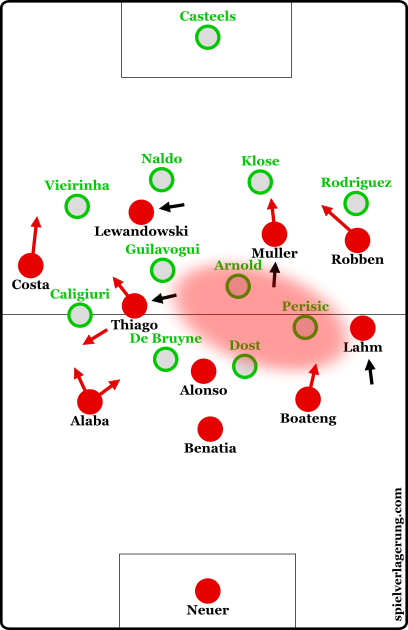Super Cup: Wolfsburg – Bayern 1:1 (5:4)
|
Despite leading for the majority of
the second half after Robben opened
the scoring, Guardiola is still
without a Super Cup victory for
Bayern as Wolfsburg stole a victory
on penalties after Niklas Bendtner
equalised late on.
Douglas Costa got his first competitive start for
Bayern on the left wing and
demonstrated an incredible
explosiveness in his pace whilst
somewhat surprisingly, Thomas Muller
started as the right 8 alongside
Thiago. De Bruyne was in his usual position behind Bas Dost up front. The system was generally a 4-2-3-1 shape whilst it became a 4-4-2 later on with the introduction of Niklas Bendtner. |
|
|
|
Bayern’s Asymmetrical Build-Up Shape
|
For the first 45 minutes, Bayern
fielded an asymmetrical shape during
their early possession. From the
initial 4-1-4-1 shape, Alaba stayed
deep in a 3-chain whilst Lahm pushed
higher up into the midfield line. FIn reaction, Hecking’s side pressed in a lopsided 4-3-3 shape as Caligiuri moved higher on Alaba with Perisic deeper against the advanced Lahm. Initially the outcome was poor, as Alaba started well and Bayern prospered to some degree down their left. However as Wolfsburg grew into the game, they slowly became on top due with improved pressing and defensive control. |
|
|
|
Bayern’s Lopsided Build-Up Shape |
Early on
Wolfsburg struggled to deal with Bayern’s developments
down the left as Costa was able to create 1v1s with the
support from Lewandowski who occupied Naldo whilst
Thiago and Alaba created a foundation deeper.
However once Wolfsburg improved and closed out these
spaces much better, Bayern’s possession game struggled
without any presence in the middle of the pitch as their
focus was to the wings. Changes from Guardiola fixed
this issue somewhat but still they could never develop a
dominance over the Wolves whose newly-found stability
proved key. During wide possession Bayern failed to
utilise diagonal passing to circulate the ball into more
threatening areas and the ball instead became isolated
out wide.
Bayern Against the Ball
Without the ball Bayern were structured in a much more
‘standard’ 4-1-4-1 though that itself had some
interesting variations in the pressing during
Wolfsburg’s early possession. The Bavarian pressing
caused issues for Hecking’s side who often resorted to
long balls towards Dost as apposed to directly
challenging the press of Lewandowski and co.
Lewandowski would situationally receive support from the
ball-near central midfielder who would push up and help
direct the ball towards the wing to create trap
opportunities whilst Alonso and the ball-far CM would
also move up slightly to maintain good spatial
compactness within the 10 space. Another variation was
where the ball-far winger would push up alongside
Lewandowski to the opposite centre-back in order to
restrict potential switches by Lewandowski’s centre-back
under pressure.
Wolfsburg Early Issues and
Improvements
Hecking’s side were second best during the opening
stages of the match as they had some issues in their
defensive organisation. During Bayern’s wide possession
they struggled to close out the spaces on the wings
which resulted in Douglas Costa threatening throughout
the opening 20 minutes.
On the left they often struggled to press Alaba and
suffered from a lack of access as the Austrian could
push up with multiple passing options both vertically
and diagonally.
As the game progressed, Wolfsburg improved their
pressing with greater ball-orientation whilst they
closed the passing lanes into midfield much more
effectively.
Their compactness in the 4-4-1-1 increased which only
served to emphasise Bayern’s lack of presence through
the middle and connections across the structure. In
Bayern’s early possession there became a period where
they played long diagonal passes towards Costa and
Robben (primarily the former) and despite Boateng’s
excellent distribution it was ineffective as even if the
pass was completed, the duration of the pass was enough
for Wolfsburg to prepare for a strong press on the
touchline. With more long passing on show, the short
combinations in smaller scenes became more and more rare
as Bayern lacked the connections to execute such
patterns despite Pep’s best attempts to amend these
issues.
Changes from Pep
Throughout the game, Pep made numerous subtle changes
either to the shape as a whole or smaller switches
involving the orientation and movements of individuals
or small groups of players.
Guardiola shifted from the lesser orthodox build-up
shape from the first 45 minutes to a more standard one
which was much more symmetrical. The change was mainly
in the full-backs as Alaba started to make more forward
movements as apposed to the deeper role he previously
possessed whilst Lahm came slightly deeper on the
opposite side of the pitch. As the game progressed, the
German right-back also became more oriented towards the
half-space though this was a change initially without
relation to the building shape.
Around the 15th minute mark, Lahm began to move inside
towards the centre of the pitch instead of the wide
positioning which he had adopted at the start of the
game. Throughout Bayern’s early possession it seemed
like Pep wasn’t satisfied with their progression down
the right side of the field as they had some key issues
in the connections and spacing. Their shape in
possession often left massive gaps within the centre of
the pitch which wasn’t helped by the presence of Alonso
whilst Lahm was out on the touchline providing little
support in his team’s possession game. In order to amend
this issue, Guardiola moved Lahm towards a more central
position in the right half-space and by doing this
looked to improve the connections through the centre and
simply filling the gap. In turn the previously isolated
Thiago on the left was supported by a central presence
which was lacking beforehand.
Another change throughout the games was the movements
and orientation of both Muller and Robben. As the game
progressed, the former adopted more of a
horizontally-based role whilst Robben started becoming
inside. In addition, the two made a straight rotation
frequently during different stages of the game.
The reason for Muller’s change in orientation is likely
the movement of Lahm as is the process of spacing in
juego de posicion – there can be a max of 2 players on
the same vertical line. Having just 2 players on the
same vertical line is not always optimal either as it
reduces the ability for diagonal passing whilst it is
much easier for the defence to control through the use
of basic cover shadows. Additionally, the raumdeuter
made balancing movements for the inside orientation of
Robben. Whilst both the Dutch winger and Lahm came
inside, Muller was often on the touchline to maintain
the width and balance in the structure.
Aside from the positional features of these changes,
Muller’s movement opened central passing lanes to
Lewandowski which Boateng could utilise at times with
his laser passing. Otherwise Bayern struggled somewhat
to develop direct central access so this situationally
provided an effective means of finding Lewandowski
through vertical passing.
Although these in-game changes had some positive result,
they weren’t enough to fix the deficiencies in Bayern’s
system and for the majority of the game they lacked the
connections to develop an effective possession game.
This may have been the inspiration for introducing Vidal
late on aside from the obligatory new signing appearance
however the impact was not as desired.
|
|
Traduci la pagina web da questo link |
Super Cup: Wolfsburg – Bayern 1:1 (5:4)
@TomPayneftbl
http://t.co/wY1QuDOd0p pic.twitter.com/5M81rf1rBC
— Alleniamo.com (@Alleniamocom) 15 Agosto 2015







